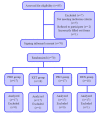Efficacy of ketamine, propofol, and dexmedetomidine for anesthesia in electroconvulsive therapy in treatment-resistant major depressive disorder patients: a double-blind randomized clinical trial
- PMID: 36571375
- PMCID: PMC9979203
- DOI: 10.4103/2045-9912.350860
Efficacy of ketamine, propofol, and dexmedetomidine for anesthesia in electroconvulsive therapy in treatment-resistant major depressive disorder patients: a double-blind randomized clinical trial
Abstract
Electroconvulsive therapy (ECT) is one of the therapeutic opportunities for patients with psychological disorders when they may decline to take medication. We sought to systematically compare the anesthetic efficacy of ketamine, propofol, and dexmedetomidine for electroconvulsive therapy in treatment-resistant major depressive disorder patients. This double-blind trial enrolled treatment-resistant major depressive disorder patients (n = 85) who had been hospitalized for ECT in the Amir Kabir Hospital's psychiatric ward (Arak, Iran). The ketamine, propofol, and dexmedetomidine groups received a dose of 0.2 μg/kg ketamine, 1.5 mg/kg propofol, and 0.8 mg/kg dexmedetomidine, respectively. In all intervention groups, 10 mL of interventional drugs was injected intravenously for 10 minutes, and in the placebo group, 10 mL of normal saline was given over the same period. The dexmedetomidine group's blood pressure was revealed comparatively lower at all times. Dexmedetomidine-treated patients showed their marked satisfaction, while those treated with propofol had shorter recovery time, shorter seizure duration, and shorter time to achieve an Aldrete score of 9-10 and increased relaxation, and next dexmedetomidine produced deeper relaxation. Propofol could shorten recovery time and seizure duration, and enhance relaxation, while dexmedetomidine was associated with higher patient satisfaction. Considering that any anesthetic which does not shorten seizure duration may serve efficiently for ECT and that ketamine-treated patients had more prolonged seizure duration, the preferred drug can hence be considered from various angles, thereby offering anesthetic agents with highly favorable efficacy in treatment-resistant major depressive disorder patients needing ECT. The drug choice thus depends on physical conditions, underlying diseases, and psychiatrist consultation.
Keywords: analgesics; depressive disorder; dexmedetomidine; electroconvulsive therapy; ketamine; propofol; psychological disorders; seizure.
Conflict of interest statement
None
Figures


Similar articles
-
Effects of propofol and ketamine as combined anesthesia for electroconvulsive therapy in patients with depressive disorder.J ECT. 2012 Jun;28(2):128-32. doi: 10.1097/YCT.0b013e31824d1d02. J ECT. 2012. PMID: 22622291 Clinical Trial.
-
Propofol and methohexital as anesthetic agents for electroconvulsive therapy: a randomized, double-blind comparison of electroconvulsive therapy seizure quality, therapeutic efficacy, and cognitive performance.J ECT. 2007 Dec;23(4):239-43. doi: 10.1097/0b013e31814da971. J ECT. 2007. PMID: 18090696 Clinical Trial.
-
Effect of Low Dose of Ketamine on Learning Memory Function in Patients Undergoing Electroconvulsive Therapy-A Randomized, Double-Blind, Controlled Clinical Study.J ECT. 2017 Jun;33(2):89-95. doi: 10.1097/YCT.0000000000000365. J ECT. 2017. PMID: 27828927 Clinical Trial.
-
Comparison of the effect of intravenous anesthetics used for anesthesia during electroconvulsive therapy on the hemodynamic safety and the course of ECT.Psychiatr Pol. 2017 Dec 30;51(6):1039-1058. doi: 10.12740/PP/75635. Epub 2017 Dec 30. Psychiatr Pol. 2017. PMID: 29432502 Review. English, Polish.
-
Effects of Ketamine Anesthesia on Efficacy, Tolerability, Seizure Response, and Neurocognitive Outcomes in Electroconvulsive Therapy: A Comprehensive Meta-analysis of Double-Blind Randomized Controlled Trials.J ECT. 2020 Jun;36(2):94-105. doi: 10.1097/YCT.0000000000000632. J ECT. 2020. PMID: 31725054
Cited by
-
The Effects of Remifentanil, Dexmedetomidine, and Metoral as Adjuncts to Thiopental on Hemodynamic Status After Electroconvulsive Therapy in Patients with Major Depressive Disorder: A Randomized Controlled Clinical Trial.Anesth Pain Med. 2023 Sep 19;13(5):e139383. doi: 10.5812/aapm-139383. eCollection 2023 Oct. Anesth Pain Med. 2023. PMID: 38028112 Free PMC article.
-
Anesthetic Influence on Electroconvulsive Therapy: A Comprehensive Review.Neuropsychiatr Dis Treat. 2024 Jul 31;20:1491-1502. doi: 10.2147/NDT.S467695. eCollection 2024. Neuropsychiatr Dis Treat. 2024. PMID: 39100572 Free PMC article. Review.
References
-
- Safari F. Evaluation of the effect of dexmedetomidine on the acute hyperdynamic responses, duration of seizure activity and recovery times in patients undergoing ECT. J Iran Soc Anaesthesiol Intensive Care. 2016;38:62–67.
-
- Shah AJ, Wadoo O, Latoo J. Electroconvulsive therapy (ECT): important parameters which influence its effectiveness. BJMP. 2013;6:a634.
-
- Chawla N. Anesthesia for electroconvulsive therapy. Anesthesiol Clin. 2020;38:183–195. - PubMed
Publication types
MeSH terms
Substances
LinkOut - more resources
Full Text Sources
Medical

